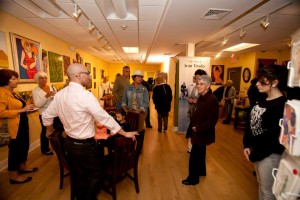Artists are Communicators
There is misunderstood belief that artists have to be isolated from society instead of being connected to it. Some artists believe that art should speak on its own and if people don’t connect with their art there should be no need to provide explanations. As artists we speak through art, I agree. People should connect and find meaning in the content of an art piece on their own. However, we can provide insights in our source of inspiration, our creative process, our artistic influences, methods, and techniques. That gives us power to be communicators. Not everyone is educated in the arts. We have the power to be influential and an inspiration to others. If we decide to connect with people and share our knowledge and feelings (funny coming from a man) we can expand the power of communication of our art. Artists gave away this power to agents who turned the art into a market trade product with no substance of life behind it.
 In Frames of Mind: Theory of Multiple Intelligences, Howard Gardner mentions interpersonal intelligence as the skill to connect with others. As in any field of practice, you can be successful and have all the skills but by not having interpersonal intelligence you might be closing doors to yourself. It is fine to let art speak by itself. It is a great experience. Nevertheless, it is not a license to be a contemptibly obnoxious person or a self-made social reject. Some artists need an ego-check. There is a very fine line between eccentric and just plain weird. If people can connect with you, they will connect with your art. It is time artists come out of obscurity and mingle with people and be more than a signature at the corner of the paint, to regain an influential social status and use our sensitivity to guide others and inspire future artists, and why not? Future clients as well.
In Frames of Mind: Theory of Multiple Intelligences, Howard Gardner mentions interpersonal intelligence as the skill to connect with others. As in any field of practice, you can be successful and have all the skills but by not having interpersonal intelligence you might be closing doors to yourself. It is fine to let art speak by itself. It is a great experience. Nevertheless, it is not a license to be a contemptibly obnoxious person or a self-made social reject. Some artists need an ego-check. There is a very fine line between eccentric and just plain weird. If people can connect with you, they will connect with your art. It is time artists come out of obscurity and mingle with people and be more than a signature at the corner of the paint, to regain an influential social status and use our sensitivity to guide others and inspire future artists, and why not? Future clients as well.

Visual Intelligence
There are three classes of people:
those who see, those who see when they are shown, those who do not see.
Leonardo Da Vinci
Howard Gardner proposed in Frames of Mind: The Theory of Multiple Intelligences that intelligence as ‘one thing’ is too limiting to account to the broader range of human abilities and capabilities. He separates intelligence in nine modalities (I’m sure that the list will continue growing):
Look Up by Iván Tirado
It is possible that the first group of people coming to mind when one hears ‘visual intelligence’ is artists. Not only people who can draw, paint, sculpt, or design have visual intelligence. Visual intelligence is extended to sports. Court vision in basketball is important to shoot and pass the ball. The same applies in football, baseball, and boxing. Dancers too require that sense of space when they perform. Even today’s video games require visual intelligence with those virtual words that make me dizzy about five minutes into the game.
I do believe that artists have visual intelligence indeed. I also believe that artists share bodily-knestetic intelligence too in order to transfer their vision into a tangible creation. Bodily-knestetic intelligence is not only for sports and dance. I believe we can call it ‘technique’. Artists also share logical-mathematical intelligence. Moreover, artists are also existential or spiritual intelligent. Why it seems like I’m focusing in artists and visual intelligence? Well, I am an artist. I also stink at music and most sports. The fact is that my favorite aspect of visual intelligence because it is not about what we see with the eyes.
Blind people develop visual intelligence to make sense of their environment. Is that perception of space that goes beyond the world we see. Visual intelligence can inform the other intelligences allowing us to become aware of a different kind of world. We can close our eyes and see it. Our senses become consumed with it. This intelligence allows the development of problem-solving skills, capturing and interpreting information, and perceived the world we see with the naked eye and the world not seen. Leonardo Da Vinci called it ‘the reflective eye’. Leonardo believed that ‘the artist sees what others only catch a glimpse of‘.